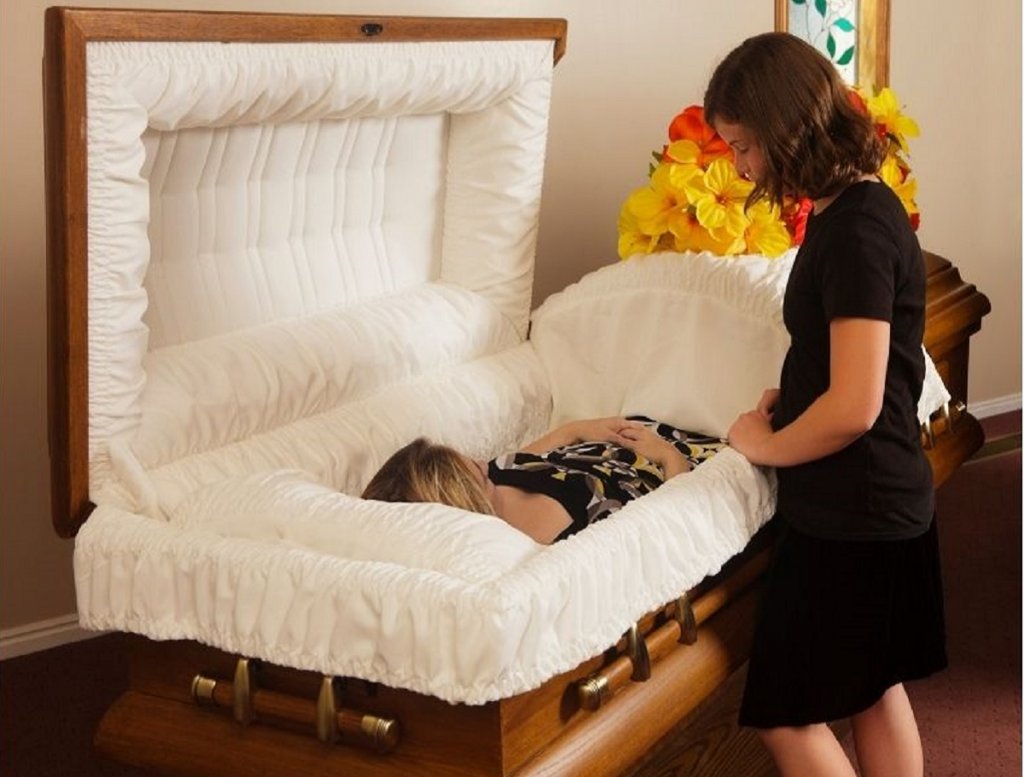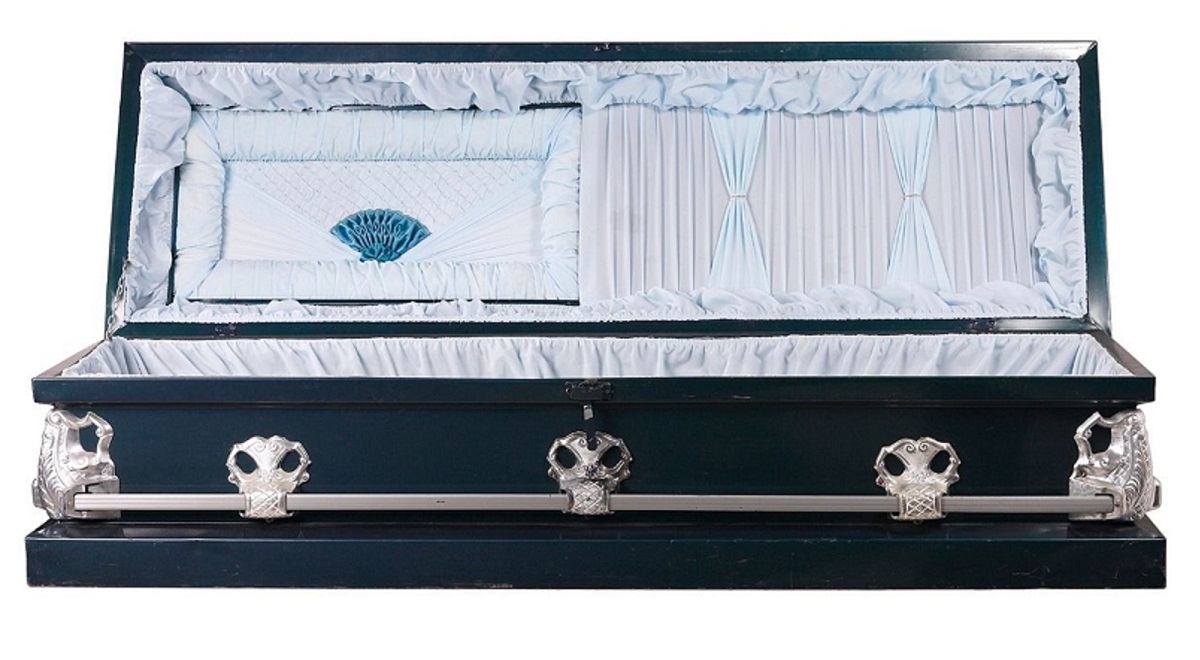The primary reason the funeral home covers the legs in the casket of the deceased is that the face and hands reflect their humanity more than the torso and legs. There is no need to view the legs when paying your respects or sharing a brief message with the deceased.
Funeral homes cover the legs in the casket when displaying the body in an open-casket wake or funeral. Old wives’ tales and urban legends suggest nefarious reasons, but why they do it is sound.
When families want a viewing, the funeral director presents two display choices: a half-couch casket or a full-couch casket. The half-couch model only shows half of the body, as the name implies, whereas a full-couch model offers a view of the entire body. While the lid of the casket on the full-couch model opens completely, the half-couch splits like a Dutch door near the deceased’s waist.

Why The Funeral Directors Cover The Legs In Caskets
The caskets used for burial also display the body during viewing. Most states have laws requiring embalming if the family wants open casket services. While there are several reasons why the legs are covered in a casket, none of them are as exciting as people might guess.
- So Mourners Can Focus on the Deceased’s Face: Family members and friends who are grieving will focus on the loved one’s face at the funeral service. Although someone might pause to touch a hand or shoulder, the upper body offers the personalization mourners are looking for.
The real artistry in preparing a body goes into ensuring that the facial expressions of the deceased seem peaceful. Directing focus toward the face is the main reason the legs are covered.

- Trauma to the Body: Unfortunately, sometimes a body is left traumatized in death. Although there is a lot an undertaker can do, there are limits. Severe trauma in the lower extremities may necessitate the legs to be covered. Drawing attention to lost or damaged body parts can cause unnecessary concern on behalf of friends and family members.
- Religious or Cultural Reasons to Cover the Legs in a Casket: There may be religious or cultural reasons not to show the legs. In Judaism, for example, covering the legs is seen as important for modesty.
- Shoes Often Don’t Fit Properly After Death: As you can imagine, it is difficult to get shoes onto a dead person. Once rigor mortis sets in and the body has been embalmed, manipulating the body becomes harder. One reason to cover the legs is that the deceased is not wearing shoes.
- Covering Legs To Save Money: A mortician has a very big task to take a dead body and make it look like the loved one you remember. Only having to focus on half of the body takes less time, so covering the legs saves money in body preparation time. The is little or no difference in the pricing of full-couch vs. full couch coffin styles.
- Casket Fit: Caskets and coffins come in standard sizes. Although the funeral director will not do anything disrespectful or inappropriate to get the deceased to fit into a coffin, sometimes it is a tight squeeze. Often a slight bend in the knee is all it takes to help the person fit in a standard-size coffin, but that would look unnatural. Not showing the entire body gives them a little flexibility.
- Flowers on the Casket: Although it is right to ask which came first, the custom of only viewing half the body or the flowers on the casket, one thing is undoubtedly true: draping and displaying flowers over a coffin do add a beautiful touch.




Choosing The Right Casket For Display
The funeral industry is a huge industry with good reason. Everyone dies eventually, and in the United States, the funeral director or mortician presents the final choices for the deceased’s body. Whether you want cremation or traditional burial, services are costly, and by law, the funeral consultant must share the costs with you. This includes the prices for caskets.
Casket selection is a personal choice; however, finances may dictate the material and degree of ornamentation you can afford. There is also body size and shape to take into consideration.
Most people can use a standard-size casket, which is typically 84″ long, 28″ wide, and 23″ high, to accommodate those up to 6’5″ or more and 350 pounds. The funeral director often can position a somewhat larger body to fit a standard-sized casket. For those who are taller or wider, he may suggest an oversized casket that is deeper, wider, or longer. Custom or oversized caskets come at a higher cost.
For the visitation and open-casket funerals, the goal is to make the body appear peaceful and relaxed., Renting an oversized casket may be worth the extra in cases where the body will be fitted in a standard-size vessel for burial. When the body is cremated after visitation, the cremains might be placed in an urn or buried.

Does The Funeral Home Cut Off The Legs?
When 6’7″, 300-pound funk guitarist James Hines died in 2004, the funeral director covered his legs in the casket. Family and friends viewed his body laid out in a half casket by the Cave Funeral Home of Allendale, SC, and some commented that the casket looked too small, but Hines’ widow Ann Hines thought no more about it until ongoing rumors that James’ legs were cut off to fit into the casket motivated her to question the funeral home.
Once the coroner and the South Carolina Board of Funeral Service became involved, it was discovered that an unlicensed worker sawed off his legs between the ankle and calf and put him – and his feet – back in the coffin. The ensuing criminal investigation found violations of South Carolina law and eventually led to the mortuary paying fines and shutting its doors in 2009, but not before an urban legend resurfaced that mutilating the body was standard practice in the funeral industry.
This type of thing is not the standard of care provided by funeral directors, who are usually supportive, compassionate individuals who present the grieving with choices. While cutting off the legs did not harm the deceased, funeral personnel are bound to respect the remains.
Normal practice is to suggest a larger casket, not desecrate the body. Ann Hines claimed that Cave never offered the option of an oversized casket for her larger-than-life husband. Apparently, James Hines had prepaid funeral expenses, but the funeral home did not want to pay extra for a larger burial container.
Covering the legs in the casket is done to enhance the dignity of the loved one, not help a funeral home’s bottom line.

